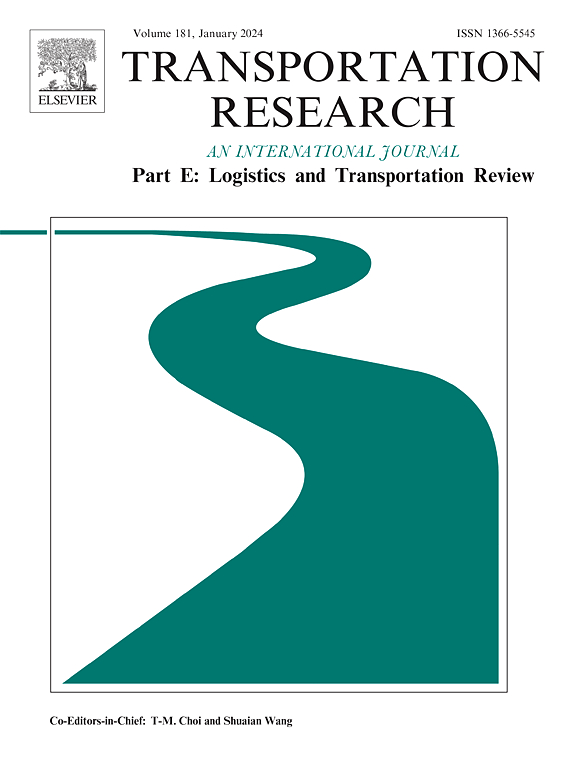Demand uncertainty aware curbside space allocation planning in shared-use transportation networks
IF 8.3
1区 工程技术
Q1 ECONOMICS
Transportation Research Part E-Logistics and Transportation Review
Pub Date : 2025-07-21
DOI:10.1016/j.tre.2025.104245
引用次数: 0
Abstract
Efficient management of curbside space is gaining more attention as cities confront increasing traffic, curbside requirements, and mobility patterns. Given their increasing significance in meeting diverse shared-use mobility requirements, the absence of optimal planning on curbside areas can lead to networkwide negative impacts. This study examines demand uncertainty for planning at several temporal resolutions. Our developed approach identifies the optimal curbside space allocation planning strategies to enhance passenger-level services, considering the Curb Productivity Index and the uncertain arrival distribution of Shared-Use Mobility (SUM) service units throughout the curbside networks. We integrated a core optimization module to adjust capacity over various time scales and find the optimal allocation plan. Further, we integrated a sample-based heuristic to allow decision-making at multiple levels of granularity (allocating space hourly versus adjustments occurring every five minutes due to interconnected infrastructure technologies or analogous factors). The proposed solution methodology is demonstrated for a network of curbsides with known demand distribution parameters (truncated Normal with mean and standard deviation for hourly demand). The results suggest that the allocation plans are highly sensitive to the decision interval (minutes vs. one-hour), and the coarse-resolution decision-making may overestimate the performance of a curbside allocation plan, underscoring the need for fine-resolution allocation plans in cities.
基于需求不确定性的共享交通网络路边空间分配规划
随着城市面临日益增长的交通、路边需求和交通模式,路边空间的有效管理越来越受到关注。鉴于它们在满足各种共享出行需求方面的重要性日益增加,缺乏对路边区域的优化规划可能会导致整个网络的负面影响。本研究考察了在几个时间决议下规划的需求不确定性。我们开发的方法确定了最优的路边空间分配规划策略,以提高乘客水平的服务,同时考虑了路边生产力指数和整个路边网络中共享出行(SUM)服务单元的不确定到达分布。我们集成了一个核心优化模块,在不同的时间尺度上调整容量,找到最优的分配方案。此外,我们集成了一个基于样本的启发式方法,允许在多个粒度级别上进行决策(每小时分配空间,而不是由于相互连接的基础设施技术或类似因素每五分钟进行一次调整)。所提出的解决方案方法是针对已知需求分布参数的路边网络进行演示的(每小时需求的平均值和标准差截断正态)。结果表明,分配方案对决策间隔(分钟与1小时)高度敏感,粗分辨率决策可能高估了路边分配方案的性能,强调了城市需要细分辨率分配方案。
本文章由计算机程序翻译,如有差异,请以英文原文为准。
求助全文
约1分钟内获得全文
求助全文
来源期刊
CiteScore
16.20
自引率
16.00%
发文量
285
审稿时长
62 days
期刊介绍:
Transportation Research Part E: Logistics and Transportation Review is a reputable journal that publishes high-quality articles covering a wide range of topics in the field of logistics and transportation research. The journal welcomes submissions on various subjects, including transport economics, transport infrastructure and investment appraisal, evaluation of public policies related to transportation, empirical and analytical studies of logistics management practices and performance, logistics and operations models, and logistics and supply chain management.
Part E aims to provide informative and well-researched articles that contribute to the understanding and advancement of the field. The content of the journal is complementary to other prestigious journals in transportation research, such as Transportation Research Part A: Policy and Practice, Part B: Methodological, Part C: Emerging Technologies, Part D: Transport and Environment, and Part F: Traffic Psychology and Behaviour. Together, these journals form a comprehensive and cohesive reference for current research in transportation science.

 求助内容:
求助内容: 应助结果提醒方式:
应助结果提醒方式:


